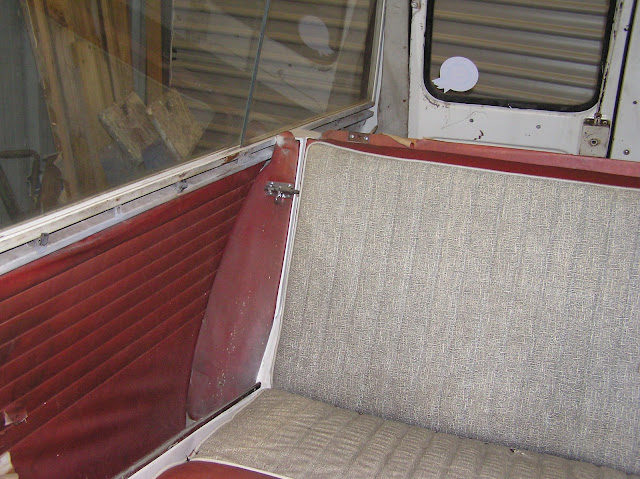
|
|
Vinyl swatches from 1961 - Spanish Red and Grey Fleck.
The red is quite a lot darker in real life |
 |
| A few bits of trim missing |
At this early stage worrying about interior trim seems a bit premature, but with plans of registering and running the car before finishing the restoration, I'll need to get the trim sorted out soon. The problem is that quite a bit of the original trim is missing, and with very few Travellers or even early English Mini sedans in Australia, its going to take a bit of sorting out. Its not helped by some of the contradictory information published on some of the better known websites. I can be pretty certain about the trim that is present in the car, but there are still a few gaps. The "Colour Finishes and Upholsteries" brochure from 1961 shows clearly the grey fleck and Spanish red used on the seat covers, but doesn't supply any of the minor details or say anything about the other trim apart from saying that the carpet is red. Luckily My seats are still there and although the bases have been re-covered I can tell that they have welded rather than stitched flutes, the flutes are narrow and the seats have white rather than red piping. In a sedan these would be regarded as Austin seats, but I suspect they are really Longbridge seats.
The door cards are missing, but I can tell from the rear quarter panel cards that they would have been Spanish red with welded flutes.
 |
| Grey headlining material |
The headlining and most of the minor trim is light grey headlining vinyl which is embossed with a sort of square weave pattern. Interestingly this material is still available. It must have been very widely used on British cars as I've found it listed as being for Minis, Morris Minors and MGs with various suppliers. This material is used on most of the small sections of trim around the rear windows and rear doors and on the dash board either side of the speedo. It is quite stained on the headlining and dirty everywhere else, but I scrubbed a bit of it with a nailbrush and hand cleaner and it came up really well. Some of it will need to be replaced, but a lot of it I should be able to reuse.
 |
| What should the dash shelf be lined with? |
One area I really don't know about is the lining on the shelf of the dashboard. Its missing, which is no help. I've read that it should be the same colour as the door trims (red), match the panels either side of the speedo (grey headlining) or be black hardura, a kind of coarse grained stiff vinyl on a fibre felt backing.
In the load bay at the back most of the trim is missing. There are a couple of bits of the grey headlining stuff, that I'll be able to uses as patterns but the rest is pretty poor. The panelling in the side walls (also around the sides and across the back of the folding rear seat) is flat unfluted Spanish red. Unfortunately the very important tank cover is missing. I guess that it was made of the same material as the dash panel lining, a kind of thick black cardboard, but covered in the flat Spanish red material. Unfortunately I've only been able to find some dodgy photos of one or two and really don't have much detail about the shape or construction of the cover.
 |
| Flat red vinyl in the load bay |
The final trim question is carpet. the Traveller came with a set, but I'm pretty sure its not original and came out of something else. The rear seat back has been covered in white shaggy wool carpet which looks pretty terrible.
So all in all there's a bit to do. the seat covers have been extensively repaired in the front and really need replacing. the rear seat is OK but the red part of the base has a big tear in it. I can source repro trim from Newton Commercial in the UK, but the reports are that its good, but not great. Its also quite expensive. so I'm in a bit of a quandary. I've requested some
swatches of repro material from Newton's and a Traveller price list and catalog so I'll see what I'm up for and make a decision.





















